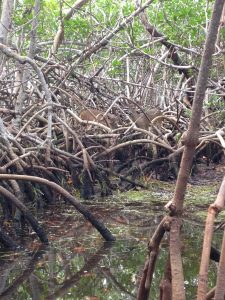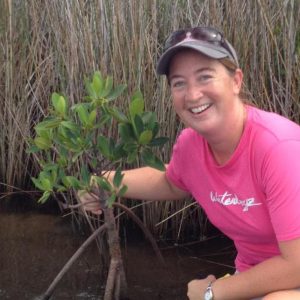
Here in northwest Florida, salt marshes ring the bays. Common in brackish and salty water, these grassy meadows form a protective ring around the shorelines where rivers and bayous empty out into larger bodies of water. While there are numerous species present in salt marsh ecosystems, the two most common are saltmarsh cordgrass and black needlerush. These tough salt and flood-tolerant species are the basis for native and restored “living shorelines,” absorbing wave energy and storm surge, processing upstream pollutants, and providing habitat for juvenile fish and invertebrates. They’re great hunting grounds for larger species like birds and mammals, as well. Salt marshes are common along the northern Gulf of Mexico and Atlantic coasts, tolerant of a wide range of hot and cold temperature extremes.

In the same niche to our south, mangrove species dominate the tidally influenced coastlines. Taller shrubs and trees, these sturdy and multidimensional plants cannot handle the cold of a north Florida winter, but thrive in tropical and subtropical ecosystems. From the lower Big Bend and Tampa south, all the way to the equator, mangroves are kings of the salty shoreline. They provide the same benefits as salt marshes, protecting the coast from erosion, providing habitat for wildlife, and metabolizing nutrients.

Over the last decade, however, the zones where one might expect salt marsh vs mangrove has started changing. Worldwide, ecologists and botanists have observed a steady march of mangroves growing beyond their usual range, both north and south of the equator.

We are not exempt from this phenomenon in Pensacola. Big Lagoon State Park has some of the healthiest stands of salt marsh in the county, but every few years we see red mangroves take root and grow among the grasses. Between 2016-2018, eight of them survived two milder winters, and grew to about 2’ tall. While they died off, we recently observed a new propagule rooted and growing at the park.
South Louisiana and the Apalachicola region have long had a steady population of the more temperate black mangroves. Over the last two decades, these populations have grown. But now with even warmer winters, biologists are finding growing stands of tropical red mangroves.
What does this mean for our salt marshes? Because they’re more treelike plants, evidence shows that mangroves moving into an area previously dominated by grasses and rushes will eventually shade out and replace them.

While mangroves essentially play the same role in the coastal ecosystem as salt marshes, there could be local repercussions if they outcompete the marshes. Animals like the periwinkle snail, blue crab, and diamondback terrapin that depend on salt marshes for survival may not be able to utilize mangroves the same way.
The movement of mangroves toward the north and south poles will continue to be a slow and gradual process, and researchers are monitoring it worldwide. The Smithsonian Institution has been coordinating a major study for several years, along with many Gulf-based universities and Estuarine Research Reserves.
 10
10
